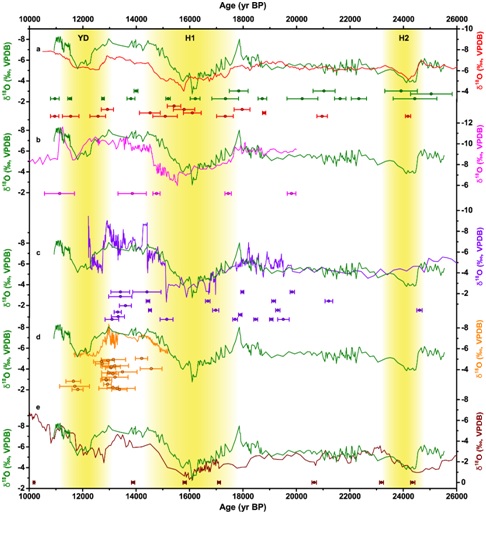Over the past two decades, speleothem studies have become more and more prevalent in reconstructing climate changes due to their precise absolute chronologies, continuous or semi-continuous precipitation, multi-proxy nature and extensive terrestrial distributions. Paleoclimatologists have utilized stalagmites from Asian summer monsoon (ASM) region to reconstruct ASM variations since the late Quaternary. However, there have been some controversies concerning how to interpret speleothem δ18O variations in eastern China. Some researchers linked Chinese stalagmite δ18O with summer monsoon intensity and amount of rainfall in a large region. Some researchers argued that variations in Chinese stalagmite δ18O are more likely to reflect changes in moisture source. In addition, Pausata et al. (2011) suggested that Chinese stalagmite δ18O was controlled by variations in the Indian summer monsoon (ISM) intensity through a modeled Heinrich 1 (H1) event. The Indian monsoon intensity was weak during Heinrich events and water vapor exported to eastern China was isotopically enriched, which caused the positive shift of stalagmite δ18O in eastern China. Furthermore, their simulation indicated that the amplitude of precipitation δ18O signal weakened with the increased distance from India to eastern China during Heinrich events. That meant Chinese stalagmite δ18O reflected changes in the ISM rather than East Asian monsoon precipitation. This view has also been supported by some paleoclimatologists.
In order to verify whether Chinese stalagmite δ18O is solely controlled by the ISM, a research team led by Prof. TAN Liangcheng from the Belt & Road Center for Climatic Environment Studies, Institute of Earth Environment, Chinese Academy of Sciences, analyzed variations in stalagmite δ18O (XL15) from Xianglong cave during 25.5–10.9 ka BP. This work was recently published in an international journal Climate Dynamics.
The results revealed that on millennial scale (including Heinrich 2,H1, Bolling–Allerod and Younger Dryas events),the XL15 δ18O record showed similar variations with ice core record from Greenland and other climate records from China and India. It also exhibited negative correlation with δ18O record from the South American summer monsoon region. This reflected the consistency of the global monsoon. However, when compared the amplitudes of stalagmite δ18O of XL15 record with those from India during Heinrich events, a weakened δ18O signal from India to eastern China was not seen as simulated by model (Pausata et al. 2011).
Moreover, Chinese stalagmite δ18O records showed three-stages (increasing-stable-increasing) in mutation mode of H1 event. In contrast, Indian stalagmite δ18O records showed consistent increasing mode. In addition, the differences between stalagmite records from eastern China and the ISM region were observed on glacial-interglacial scale and decadal scales, which indicated the influence of Pacific on Chinese Stalagmite δ18O.
In order to extract the pure Pacific’s signal from XL15 during H1 event, the scientists subtracted the Indian Mawmluh stalagmite δ18O signal (solely controlled by the Indian Ocean) from XL15 record (controlled by both the Indian Ocean and Pacific). The result was significantly negatively correlated with the Western Pacific Warm Pool (WPWP) sea surface temperature (SST). High SSTs in the WPWP would strengthen the upper convection around the region of Philippine, which would cause the northward shift of the West Pacific Subtropical High and the East Asian summer monsoon (EASM) Meiyu belt, resulting in enhanced rainfall from the single source-Pacific (already exclude the Indian Ocean signal) and negative rainfall δ18O. All the evidence above suggested that the ISM is not the sole controlling factor of Chinese stalagmite δ18O, and both the ISM and EASM could influence the Chinese stalagmite δ18O signal.

Fig.1 The magnitude comparison of XL15 δ18O record (green) andHulu (red), Songjia (plum), Bittoo (purple), Timta (orange)and Mawmluh (brown) cave records (Imaged by Tan et. al)

Fig.2 Comparison of (a) normalized XL15 δ18O record, (b) normalized Mawmluh δ18O record, (c) SST record from the westerntropical Pacifc Warm Pool, (d) difference between XL15 and Mawmluh record (normalized) (Imaged by Tan et. al)
This work was supported by the National Key Research and Development Program of China (2017YFA0603401), Shaanxi Science Fund for Distinguished Young Scholars (2018JC-023), Youth Innovation Promotion Association (2012295) and West Light Foundation of Chinese Academy of Sciences. This work is a part of The “Belt & Road” Project of the Institute of Earth Environment, Chinese Academy of Sciences.
Contact: Contact: BAI Jie, Institute of Earth Environment, Chinese Academy of Sciences, Xi'an, China. Email: baijie@ieecas.cn
 © 2015 Institute of Earth Environment,CAS
© 2015 Institute of Earth Environment,CAS Address:No. 97 Yanxiang Road, Xi'an 710061, Shaanxi, China

 Location :
Location :